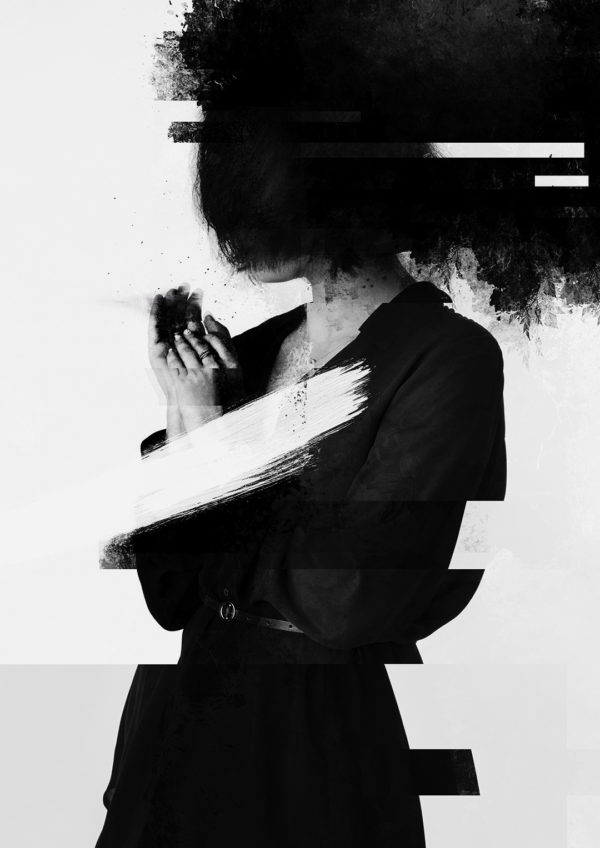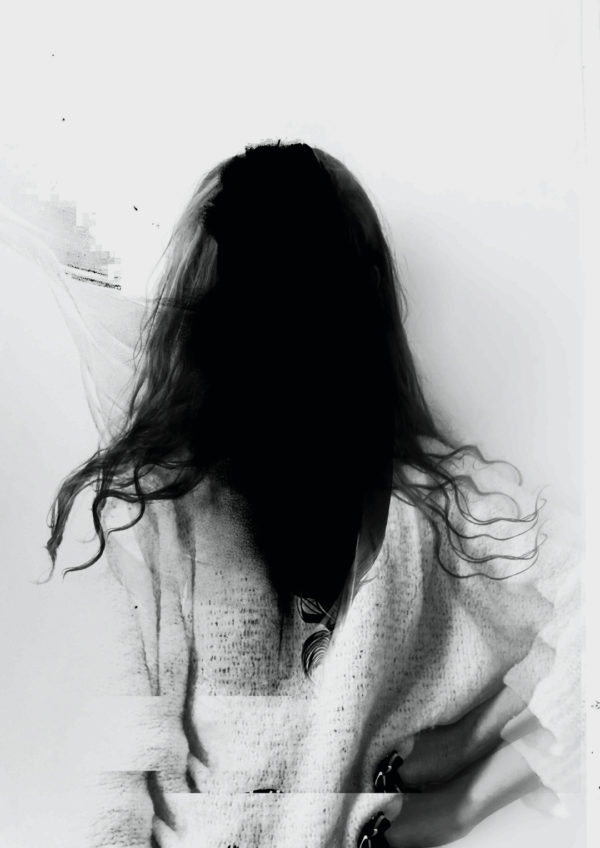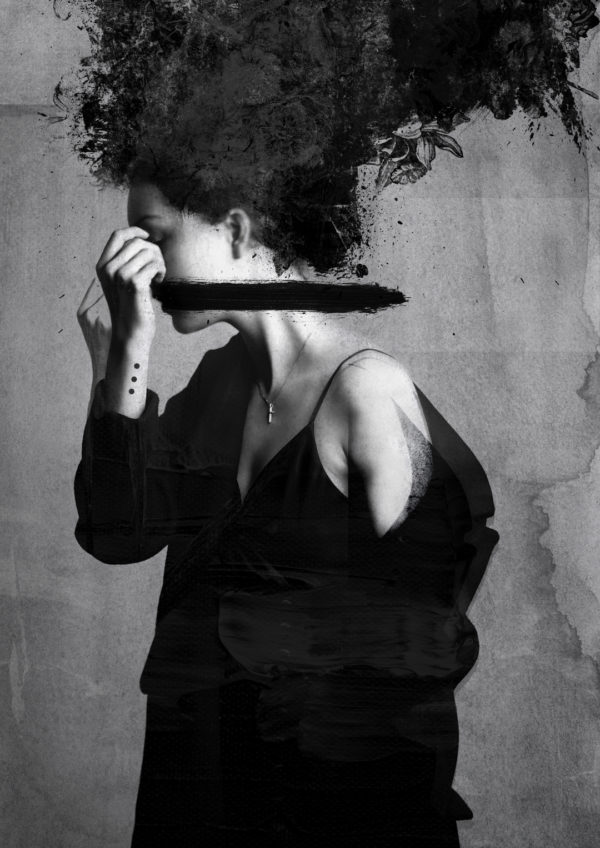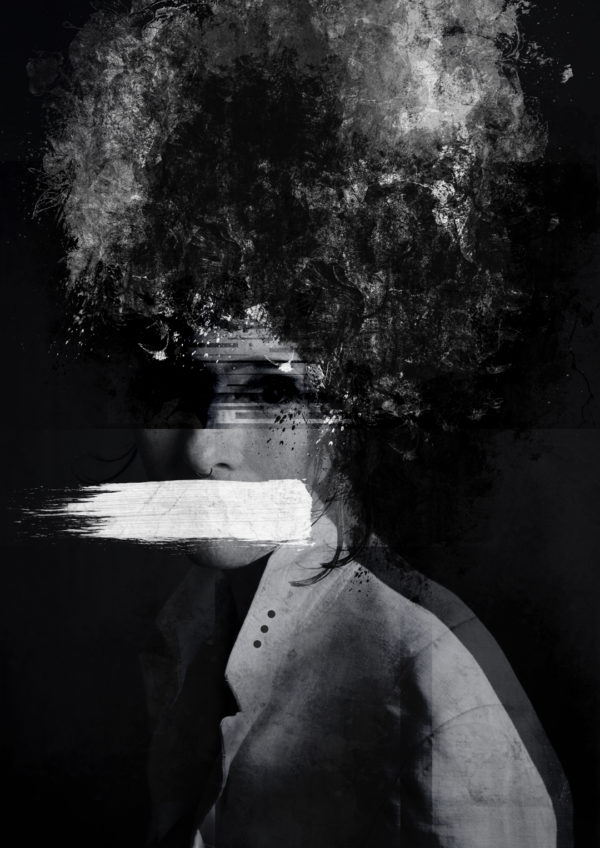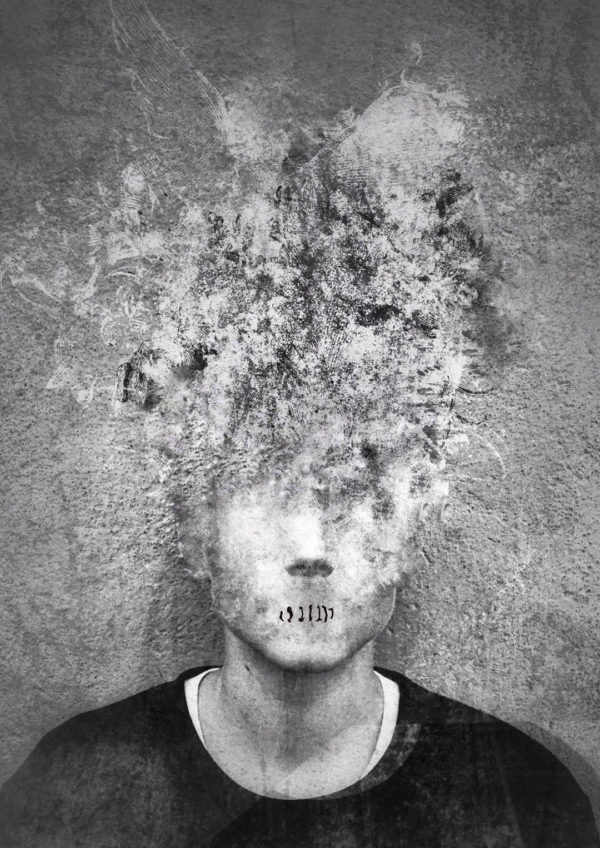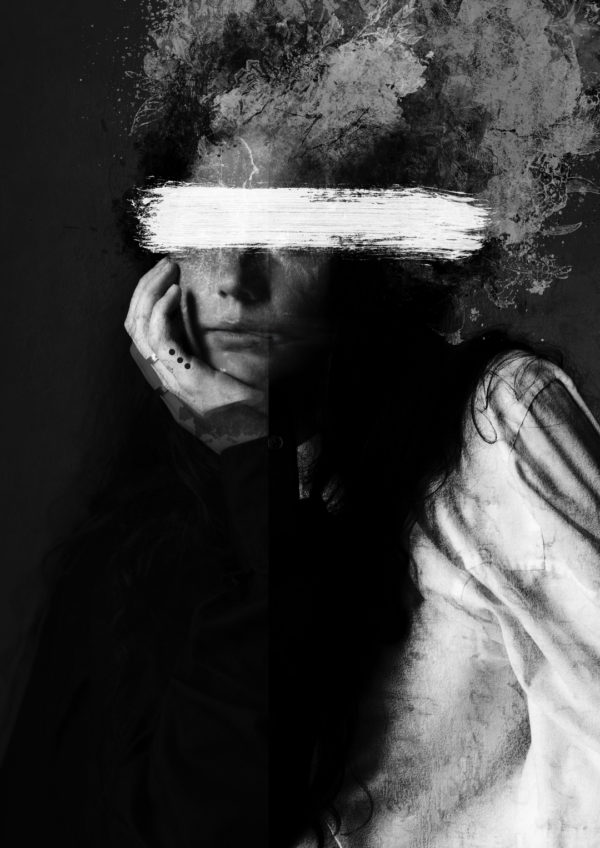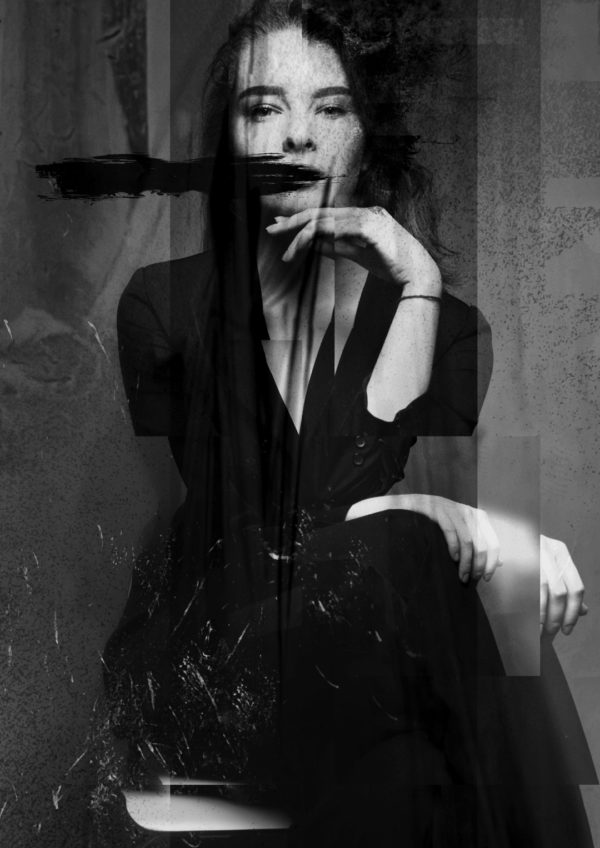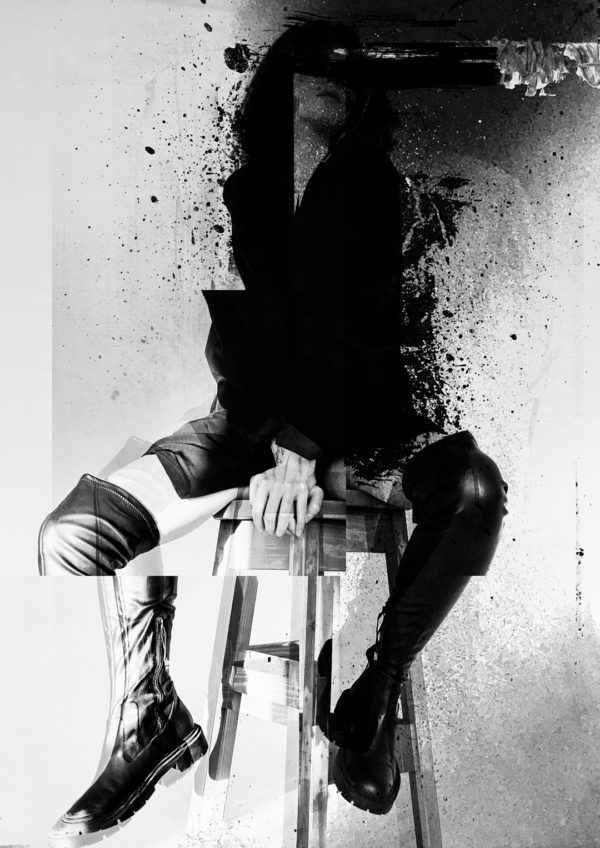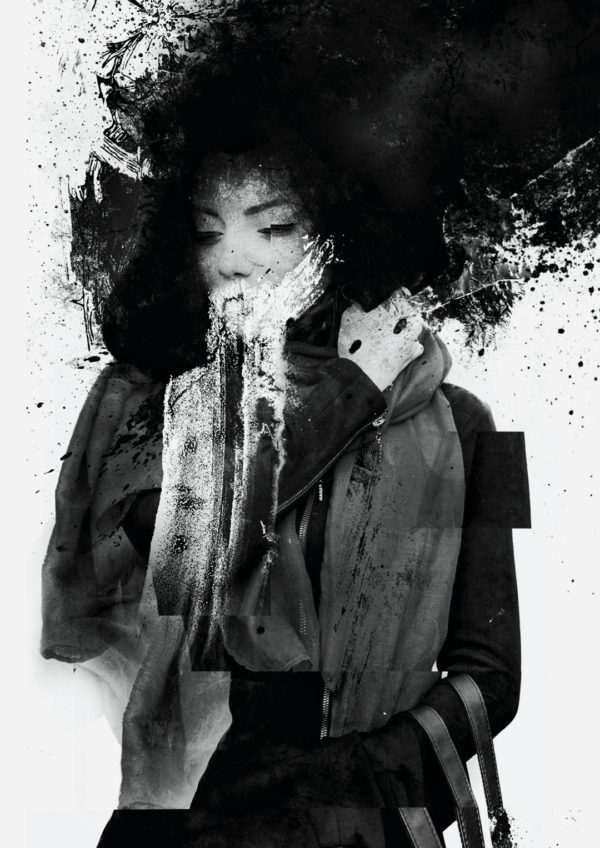
Federico Salvador, the Italian artist known as No Faith, treads a fine line between light and obscurity. Through his photo manipulations, he transfigures beauty, concealing it behind dark textures and layers, or perhaps revealing the depths of his darker side. His work invites viewers to question whether what they see is hidden or unveiled, offering a haunting interplay between emotion and abstraction.
Primarily known for his two decade journey as a musician with the darkwave band All My Faith Lost, No Faith’s foray into visual art began as a complement to his musical pursuits. Years of experimentation with graphic design and photography have since culminated in a distinctive style—one that is as dreamlike and enigmatic as his soundscapes. In this interview, No Faith reflects on his creative evolution and the emotions that drive his art.
Iconia: Your work blurs the lines between photography and digital illustration, challenging traditional notions of both mediums. How do you approach the intersection of these two forms, and what are you seeking to uncover through this fusion?
No Faith: I must admit I never thought of my art as an intersection of photography and illustration. I’ve always considered myself more of a photo manipulator, both in digital and physical forms. This is probably because the “illustration parts” are treated and sourced in the same way as the photos themselves. It’s very rare for me to draw anything in my works; I’m not particularly skilled at drawing, and it’s also time-consuming. Sadly, I don’t have much time in my life to dedicate to art, so I’ve found ways to work efficiently.
That said, I understand what you mean with your question. I guess this fusion of photography and “illustration” is my way of deconstructing the original subject of the photo, transforming it into something darker and more obscure—essentially hiding it and giving it a new kind of beauty. This is a kind of beauty that should be felt rather than seen by the viewer. I don’t know if this makes sense, but I often describe my artworks like this: “Beauty is not always obvious, yet it is always present.”
There’s a certain surreal, dreamlike quality in much of your work. How do you engage with the concept of reality versus abstraction, and what draws you to the more avant-garde realms of artistic expression?
Art is my escape from reality, from my daily life, which unfortunately isn’t very beautiful lately. For this reason, it feels natural for me to push my creations towards more abstract and dreamlike forms.
At the same time, it’s hard to detach my work from the darker side that has always been a part of me. So yes, my creations exist in a space that is both dreamy and dark. Thinking about it, this is something I’ve always done in my music as well. I’ve been a musician for over 20 years with my band all my faith lost…. Our music was dreamy, romantic, yet somehow gothic. When people asked me what genre we played, I used to reply: “ethereal darkwave.”

Photography and digital illustration offer distinct visual languages. How do you determine which medium—or combination of mediums—best conveys the essence of the narrative you wish to tell?
As I mentioned before, for over 20 years (including earlier bands) my primary focus was music. Then, due to a series of unfortunate circumstances, I had to pause my musical activities. I’m not sure if I’ll ever be able to play again, as I’m experiencing severe hearing issues.
Although I’ve been interested in graphic design and art since my youth, I have to admit that it’s only recently that I’ve started working seriously and consistently on my art. This means I’m still experimenting a lot with techniques and mediums.
A few years ago, I didn’t think I could create any physical artwork. I wasn’t even confident about my digital pieces or my art in general. But then, all of a sudden, I created a few works that made me realize I might have found my path, my “thing.”
At the moment, I’m still exploring and experimenting. I work with digital photo manipulation, physical collages, appropriation art (spray paint over fashion magazine pages), and screen printing. It’s all very spontaneous, and as long as I can maintain a consistent thread between these techniques, I’m satisfied.
Beauty is not always obvious, yet it is always present.
Avant-garde art often stems from a place of rebellion or personal exploration. How do your cultural background or personal experiences influence the themes and motifs you choose to explore in your art?
At first, I wasn’t sure if there was any deep meaning in my work. This uncertainty was one of the reasons I felt insecure about its artistic value. (By this, I don’t mean that something “beautiful” has no value—I simply didn’t want my art to be only beautiful.)
As I created more pieces, I began asking myself questions: Why am I doing this? What does this mean? Slowly, I started to realize that I was putting a lot of myself into my work—my insecurities, my need to be seen, and at the same time, my fear of exposing myself. I guess I am, in some way, the subject of my own works. I distort and dissect that subject, obscuring parts of it while bringing others to the surface—perhaps aspects that represent my true self.
There’s probably more to it. For example, take my “ghostsofashion” series, where I transform runway models into ghostly, sometimes abstract figures. Could this be a way of expressing both my love for and my perplexities about the fashion world? Perhaps you, being more immersed in this field than I am, could tell me more.
With new technologies constantly reshaping the artistic landscape, how do you incorporate digital tools or techniques into your practice while maintaining the integrity of your vision?
Since I started creating digital art, I’ve been open to using new tools and techniques, as long as I feel comfortable with them both technically and ethically.
As you know, I’m involved in the NFT world and have been fortunate enough to sell some of my artworks as digital tokens. I believe this technology has already had—and can still have—a significant impact on the art world. Like any tool, it has its pros and cons, and although the current outlook for NFTs isn’t great, I think it’s worth waiting to see what happens.
One tool I’m not comfortable using at the moment is AI. The use of AI is a very delicate topic, with ongoing controversies. Beyond the significant issue of intellectual property, my personal take on AI is that, like any tool, it requires learning and mastery. Unfortunately, 90% of AI-generated art I see feels generic and lacks identity. If you placed 100 AI-generated pieces by 100 different artists into a folder, it would be almost impossible to attribute them correctly later.
So, as of now, I don’t use AI in my work. I’ve tried it a couple of times, but I didn’t feel those works the way I feel about my other creations.

Your work has evolved over the years, yet it remains consistently subversive and experimental. How do you stay inspired and push the boundaries of your art without losing the core ethos that defines your practice?
Since my journey in art is still relatively new, I experiment a lot. However, I believe the reason I can maintain a consistent thread—or core ethos, as you call it—is that I’m old enough to recognize when I’m straying too far from it. That said, it might just be luck. Finding your style and language isn’t easy. I’ve seen many technically talented artists who, after years of creating, still don’t know where they’re going.
Your work often evokes a strong emotional response while leaving much open to interpretation. How intentional is this ambiguity, and how do you navigate the tension between guiding the viewer’s experience and allowing for personal interpretation?
I rarely think about the audience when I’m creating. This might sound like a cliché, but I create art primarily for myself.
That said, I do seek feedback from viewers, and if my work evokes a strong emotional response or allows for personal interpretation—whatever that may be—I’m happy. I believe this is what art (or at least some kinds of art) is for: striking a chord within the viewer and providing a sense of meaning (or attempting to) to their personal feelings or thoughts reflected in the piece.
What advice would you give to aspiring artists who are interested in combining photography and digital art in their work?
This is probably a more “general” advice but I think it’s a good one; the kind of advice I would give to my 20 years self: Keep going, keep experimenting, and use whatever tools you have at hand. Don’t stop until you find your voice. It might take years, but the more you try, the more chances you’ll have of finding it. Once you found it, keep pushing even harder.
www.bio.site/nofaith
@no_faith_left
